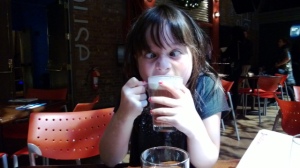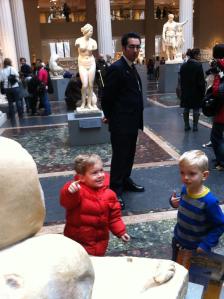I saw Mommy dissing Santa Claus
Prepare yourself for a special holiday memory.
I’m seven years old. It’s Christmas time. My mother is leaning against the butcher block in the kitchen.
“I have to tell you something,” she said to me. She paused. She struggled to suppress a laugh.
“There’s no such thing as Santa,” she said. And then the laughter came pealing out, like Christmas bells.
I think I said, “All right,” and then went on with my childhood. After all, we lived on one floor, so I could see the Christmas tree, and my parents putting presents under it, from my bed at night. Spoiler alert! If that was something people said in 1982.
And Christmas went on, too. We always hung stockings, got presents, and listened to worn cassettes of my father’s favorite carols. We drove around in the evenings to look at the neighborhood lights; we went to Rockefeller Center to see the big tree. My father decorated a meticulous tree; my mother made Belgian waffles on Christmas morning. Glad tidings, comfort, joy, all of that.
I asked my mother about this special memory recently, to see if she would admit to it. “Oh yeah,” she said. “If I couldn’t have Christmas when I was little, why should anybody else?” she said in a sing-song voice. Her sense of humor saves her from being the cynic of the Western world.
My mother emigrated to New York from Italy when she was five years old. She was born in a tiny mountaintop town, in Calabria, one of the poorest southern regions. The house she was born and lived in was built, like much of the town, around 1450. Dirt floors; smoking fires in the hearth; animals in the courtyard. There may have been a manger.
“There was no Christmas over there like here. We didn’t have much. Definitely no Santa,” she said. “Christmas was about going to church, the presepio [the Nativity scene], and the food.
“We didn’t have these endless supplies of food, everything was very limited. So whatever sugar or honey you had, you saved for Christmas.” My grandmother made Calabrese Christmas sweets, things we still love to eat, mainly variations on fried balls of dough dipped in honey or sugar: scalidi, struffoli, zeppole, turtiddi. And Christmas cookies. My husband likes to joke that cookies in my family are basically hard pieces of bread with sprinkles on them. But when you think about how getting sugar would mean walking an hour to the market town, it doesn’t seem so strange.
“And then, La Befana would come for Epiphany.” La Befana is the Italian equivalent of Santa Claus, in the form of a witch, left over from Pagan times, who comes on Epiphany Eve in January and fills stockings, certainly not plush ones with Snoopy on them like mine, with oranges, nuts, and candy. These things, part of my own children’s daily lives were cherished treats in Calabria. If you were bad, La Befana brought you coal. So that part translates. It’s the only part that does.
“When we got here, we didn’t speak English. We just didn’t get how Christmas was done,” my mother said. “The first year, we didn’t have a tree. We certainly didn’t have presents. Later we did have a tree, but Christmas was always a hard time. Your grandfather worked in construction, remember, so he was out of work all winter. So things were very lean until he could work again in the spring.” My mother was the youngest of five, with two sisters who were much older. “When they started working in the factory [they were seamstresses], I would get a doll, or they would make me a dress or a sweater. But still, the presents were the least of Christmas.”
Even in New York in the booming 1950s, where they had come to escape the want of the isolated villages of the Italian South, they still would hold sugar and honey in reserve till Christmas. I can see why the idea of Santa – even now, when we can dump entire pots of store-bought honey on trays of scalidi – would make you laugh, a little bit.
“But when we got married and you guys were little, we did Christmas the usual way. Your father always had that kind of a Christmas. His parents put up the Christmas tree on the 24th after all the kids were in bed, so they would wake up to a big surprise on Christmas morning. It was special for him. And Christmas was always special for you, too. But as for Santa, I don’t know. I just could never get into it.”
We gave Santa Claus lip service growing up, but I don’t have any memory of really believing, waiting for him to materialize in our house in the night. We didn’t have a chimney, so that didn’t help either. The presents, in my mind, were always from my parents, even though they kindly wrote “from Santa” on the labels. I have a friend whose parents did not go in much for Santa either. “We worked hard to buy those presents,” her mother told me. “Why should Santa get all the credit?” A fair point.
As for my all-American kids, two boys, ages six and three, they are excited about Santa Claus. As is their privilege. And I encourage them to believe. But what I don’t want, especially when I think of how Christmas used to be for so many in my family, and how it still is for so many people, is for the focus of Christmas to be receiving gifts.
Instead, let it be sweet treats, bright lights on cold nights, being good to each other. My three-year-old is thrilled to screaming at the sight of Christmas lights glowing in the dark; I would rather him hold on to that wonder than the mystery of a man in red bearing judgment, and Legos.
That’s not to say those two will wake up on Christmas morning to a house full of nothing but the smell of good cheer. I look forward to treating them at this time of year. What I don’t want is to dangle the old man in front of them as a threat, and tell them he’ll turn the sleigh around if they are not good; if they don’t stop yelling; if they don’t pick up their toys, or eat their vegetables. That doesn’t seem right.
So, how to handle Saint Nick? Short of calling the boys into the kitchen to deliver some bad tidings?
“Am I a good boy?” my six-year-old asked me the other day. I could see he was apprehensive of the judgment that was coming, the ups and downs of his behavior that year dancing through his head.
“Listen to me,” I held his face, looked him in the eyes. “You are a good boy. Let’s end the suspense. Santa is coming for you.”
His eyes widened. “But can he see what I am doing? Can he see me when I do things that aren’t good?”
“Santa can see that you have a good heart. You are a good brother. You are a good friend. Even good boys make mistakes sometimes, and he knows that. Everybody makes mistakes. But he knows you are good. So just keep showing him the good boy you are inside, OK?”
I guess the best thing about Santa is that it gives you something magical to believe in, in the bleakest nights of midwinter. So let him believe. But also let him believe in the good within himself, year round.
And let him believe that Santa uses the same wrapping paper as us. And has the same handwriting as me. Wouldn’t that be magical?










